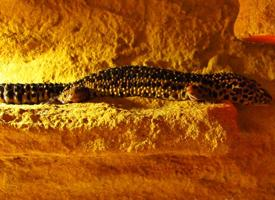
Állatleírás
The Banded Velvet Gecko, scientifically known as Homopholis fasciata, is a fascinating species of gecko that captures the attention of reptile enthusiasts and biologists alike. This species is distinguished by its striking appearance and unique characteristics that set it apart from other geckos.Originating from the lush forests and rocky terrains of Eastern Africa, the Banded Velvet Gecko has adapted to a variety of habitats. It can be found clinging to tree trunks, hiding under rocks, or dwelling in crevices, showcasing its versatile nature and ability to thrive in different environments.
One of the most notable features of the Banded Velvet Gecko is its distinctive coloration and pattern. As its name suggests, this gecko boasts a series of dark bands that contrast against a lighter background, ranging from pale greys to rich browns. This banded pattern not only adds to its aesthetic appeal but also serves as camouflage, helping it blend into the natural foliage and avoid predators.
The skin of the Banded Velvet Gecko has a velvety texture, which is another characteristic from which its name is derived. This texture is not just for show; it provides a practical advantage by helping the gecko maintain moisture in its skin, an essential trait for survival in its sometimes arid habitat.
In terms of size, the Banded Velvet Gecko is moderately sized compared to other gecko species, with adults typically reaching lengths of up to 15 centimeters (about 6 inches). Despite their small size, they are robust and agile creatures, capable of quick movements and skilled at climbing due to their specialized toe pads. These toe pads contain tiny hair-like structures that allow them to adhere to surfaces with remarkable efficiency, enabling them to navigate their environment with ease.
The diet of the Banded Velvet Gecko primarily consists of insects and other small invertebrates. They are nocturnal hunters, using the cover of night to ambush their prey with precision and agility. Their keen sense of sight and sensitive hearing make them formidable predators in the darkness.
Reproduction in Banded Velvet Geckos involves the laying of eggs, with females typically producing a clutch of two eggs. These eggs are often hidden in secure locations, such as under rocks or in tree crevices, to protect them from predators. The young geckos are independent from birth, equipped with the instincts and abilities needed to survive in their environment.
In conclusion, the Banded Velvet Gecko (Homopholis fasciata) is a remarkable species that exhibits a blend of beauty, adaptability, and resilience. Its distinctive appearance, coupled with its fascinating behavioral traits, makes it a subject of interest not only for the scientific community but for anyone intrigued by the diversity of life on our planet. As with many species, understanding and preserving their natural habitats is crucial for their continued survival and well-being.
Hasonló állatok
Új állatfotók
Top 10 állat
- Dolphin gull (Leucophaeus scoresbii)
- Japanese macaque (Macaca fuscata)
- Stone loach (Barbatula barbatula)
- Galápagos tortoise (Geochelone nigra complex)
- Russian tortoise (Testudo horsfieldii)
- Diana monkey (Cercopithecus diana)
- Greek tortoise (Testudo graeca)
- Common flying dragon (Draco volans)
- Moustached guenon (Cercopithecus cephus)
- Galápagos penguin (Spheniscus mendiculus)


